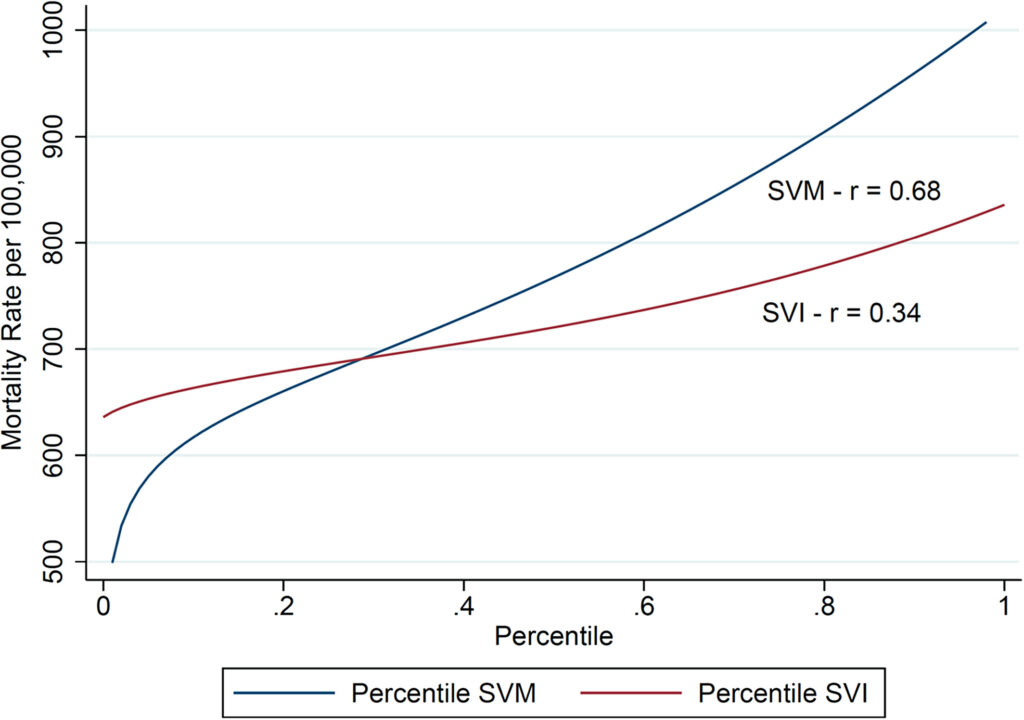
[ad_1]
A paper through Saulsberry et al. (2023) argues that the Social Vulnerability Metric (SVM) is an development over earlier social determinants of well being (SDOH) measures such because the Social Vulnerability Index (SVI). SVI makes use of census tract stage information to build total group ratings according to variables incorporated in 4 subject matters:
- “Socioeconomic Standing” together with percentages under poverty, unemployed, source of revenue, no highschool degree;
- “Family Composition & Incapacity” together with proportions elderly 65 or older, elderly 17 or more youthful, civilian with a incapacity, single-parent families;
- “Minority Standing & Language” together with proportions minority and speaks English “lower than smartly,”
- “Housing Kind & Transportation” together with proportions multi-unit constructions, cell houses, crowding, no automobile, and team quarters
I’ve summarized how SVI may well be used as a part of a distributional value effectiveness research (DCEA) method right here.
However, the Social Vulnerability Metric (SVM) proposed through Saulsberry et al. (2023) used to be built the use of multidimensional Merchandise Reaction Principle (MIRT), the use of information from the Company for Healthcare Analysis and High quality (AHRQ) SDoH Database. Key variations from SVI.
- Significance quite than equivalent weighting. SVM used to be developing the use of the MIRT method (particularly a full-information merchandise bifactor type). As in comparison to a normal latent variable regression, MIRT lets in for a couple of latent variable constructs. The the bifactor type particularly “imposes restrictions at the conventional merchandise issue research through requiring that every merchandise a lot on a number one measurement (e.g., SDoH) and just one subdomain (e.g., bodily infrastructure).” The coefficients from the MIRT are used to weight variables in SVM. This method differs from CDC’s SVI and measures such because the Space Deprivation Index (ADI), which offer equivalent weight to all variables,
- Unit of geography. SVM used to be according to ZIP code stage observations while SVI historically makes use of census tract information. Then again, AHRQ stated that the their SDoH information base will probably be up to date to document on the
county, zip code, and census tract block teams sooner or later (and SVM will probably be calculated for every of those).
The variables incorporated in SVM span 5 domain names.
- Demographic (e.g., age and race/ethnicity),
- Training,
- Financial context (e.g., unemployment charge),
- Bodily infrastructure (e.g., housing and transportation),
- Well being care (e.g., medical health insurance protection).
Observe that race/ethnicity isn’t incorporated in SVM, partly as a result of this manner SVM can be utilized to check SDoH throughout race and ethnic teams.
Effects
When evaluating SVM vs. SVI, SVM did a greater activity of predicting all-cause, age-adjusted mortality (r=0.68 vs. r=0.34). SVM used to be additionally negatively correlated with receipt of a number of COVID-19 vaccinations (r = −0.68) and finishing touch of complete vaccination (r = −0.70) and definitely correlated with age-adjusted ED visits for bronchial asthma for people elderly 0-18 (r = 0.62) and elderly 18 years and older (r = 0.60).

Whilst SVM does seem awesome to SVI, it’s reasonably extra sophisticated to create for the reason that weights don’t seem to be equivalent, and the coefficients actually span a couple of latent variables.
You’ll learn the whole article right here.
[ad_2]